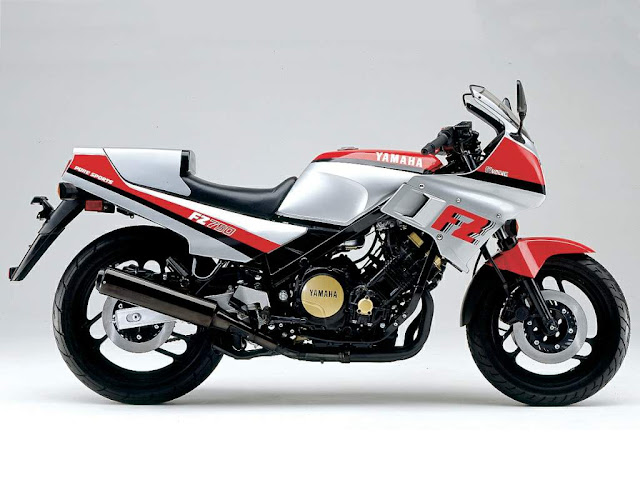Yamaha FZ750
Yamaha’s liquid- cooled, 749cc four-cylinder engine may not have gained an edge with its 20-valve layout, but was certainly an outstanding powerplant.
The original, half- faired FZ750 could not quite match the racy image of Suzuki's rival GSX-R750, but it backed-up its straight-line speed with excellent handling.
Yamaha’s modern generation of superbikes began in 1985 with the FZ750. Much more than just a superb machine with a level of all-round performance unmatched in the 750cc class, the FZ introduced the engine layout of four angled-forward, liquid-cooled cylinders, each with five valves, on which Yamaha’s big bike range would be based for many years to come.
The FZ's 749cc motor was a revelation. Tilting its cylinders forward at 45 degrees moved the centre of gravity forwards and downwards, and also made room for an innovative breathing arrangement. The bank of Mikuni downdraft carburettors sat where the cylinder head would normally have been. The airbox was shifted forwards to a new' position just behind the steering head, and the fuel tank extended down into the space normally occupied by the carbs.
Unique inlet layout
This gave a large volume of cool air with a straight run down to the engine - where it met the unique sight of three tiny inlet valves to each cylinder. Yamaha claimed the five-valve layout gave significant benefits over four-valve designs, mainly because although the total valve area was slightly smaller than with tw'o larger inlet valves, the trio’s total circumference - more important, because the valves were almost always only partially open - was larger. The figures were promising, with a peak output of I05bhp at I0,5()0rpm.
The FZ750’s chassis was designed to complement the engine layout but was conventional, based around a frame of square- section steel tubes, rather than the aluminium of Suzuki’s rival GSX-R750. Front forks were air- assisted and, like most sporty set-ups at the time, held a 16-inch front wheel. Rear suspension was by vertical monoshock. Styling was smart but conservative, with an angular half-fairing that left the black-finished motor on display.
And w'hat a motor it w'as. When Yamaha had announced the 20-valve layout the previous year, cynics had commented that it was a complex gimmick that gave no benefit over the normal 16- valve design. Some had second thoughts after riding the FZ750. whose combination of engine power and flexibility would have been impressive for a large-capacity bike, let alone a compact and easy-handling 750. No matter what engine speed was being indicated by its tachometer, the FZ surged smoothly forward when its throttle was wound open. Even from below 2000rpm it responded cleanly, when most larger-engined bikes would have hesitated. By 70()0rpm in the highest of its six gears the Yamaha was already close to lOOmph (I6lkm/h) and pulling hard. Then it kicked again, moving into warp speed and pushing its rider back as it headed for a top speed of over I40mph (225km/h).
Chassis performance was less spectacular but still very good. Handling was stable and precise. The fairly upright riding position combined with the excellent suspension to give comfortable highspeed cruising, although the screen was quite low. Other practical features included a generous fuel range, and the fact that the valve train not only proved very reliable, but required adjustment only every 28,000 miles (45,000km).
Apart from a twin-disc front brake that lacked power compared to its rivals, the FZ was an outstanding machine: fine-handling yet reasonably comfortable; rapid but remarkably tractable; aggressive in looks and feel, yet well-equipped and as suited to everyday riding as almost every other Japanese four. Unfortunately for Yamaha, it did not achieve the sales success it deserved, even when uprated a year later with a full fairing. But as the first of many great 20-valve fours the FZ750 was one of the most influential bikes of its generation, as well as one of the best.
Specification Yamaha FZ750 (1985)
- Engine Liquid-cooled dohc 20-valve four
- Capacity 749cc (68 x 51.6mm)
- Maximum power 105bhp @ 10,500rpm
- Transmission Six-speed, chain final drive
- Frame Steel twin downtube
- Suspension Telescopic front; monoshock rear
- Brakes Twin discs front; disc rear
- Weight 460lb (209kg)
- Top speed 145mph (233km/h)



















0 comments: